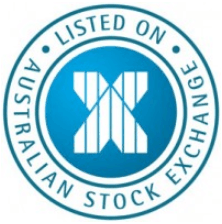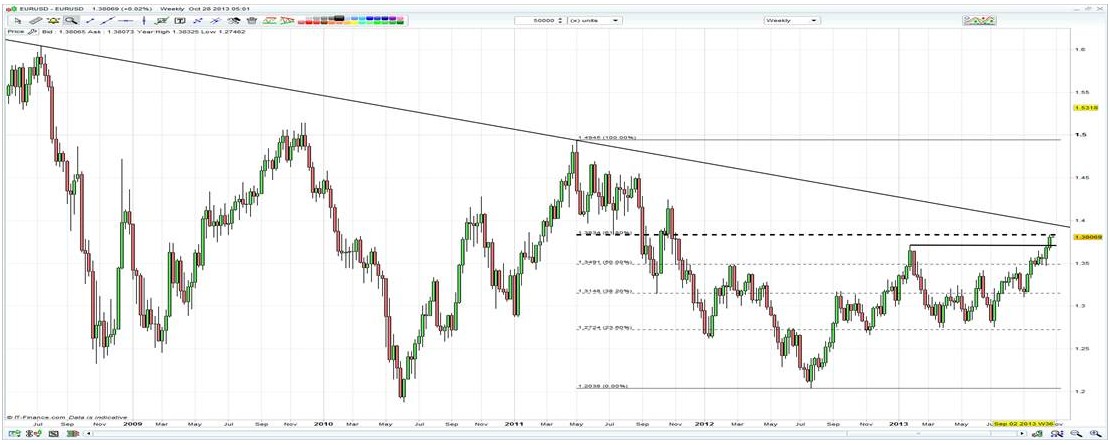
The key talking points on the floors today has been the strong rise and subsequent new five-year high in the Australian share market (the ASX 200 closed at 5441 +1.0%). Although we’ve seen a rise in the Nikkei, which has provided support, the reason behind the gains in the ASX has been premised on more on domestic issues.
There has been good buying in all sectors in the ASX, however when you see the financials being bought ahead of ANZ’s and NAB’s earnings this week, with support from the materials space, you generally know the index is going to do nicely. There doesn’t seem to be any smoking guns behind the gains in the materials space, other than some excitement ahead of the November third plenum meeting and some short covering given the calming of China’s credit markets. There have been good flows into the ANZ bank today and the results could have ramifications for the broader market, given the earnings’ thematic’s are generally shared among the other big three; thus with ANZ at fair value, we will need to see a result that delivers, or profit taking will come into the banks. However, with three of the four big banks providing investors with dividend income in early November, it’s hard to see any major downside for these names (and thus the index) ahead of this event.
What’s behind the 2% rise in the Nikkei is also unclear, although there have been a couple of articles suggesting it’s not the time to be betting against further falls in the JPY. US futures have pushed up in-line with the Nikkei, while there has been some modest buying in the AUD as well. China’s money market rates have also been equity positive, falling across the board, and as I argued last week the recent spike was only a modest fine tuning of monetary policy and that we were unlikely to see the same conditions as June. USD/CNY is also once again testing a twenty-year low and I would expect further strength in the CNY, as we see the PBOC uses this as its front line weapon again hot money inflows.
While China’s tightening of monetary conditions were the driver of a number of assets last week, there are number of factors which will either dominate or get increased attention this week. Of course US earnings will play a large part and so far the level of earnings/sales surprise are one thing, but it’s the cyclical growth that is really providing the upside for the S&P 500. Apple and Merck report today and this could set the tone of the week; although for Dow Jones followers both will have a limited impact (other than sentiment) given Apple is not even in the Dow and Merck carries a small 1.9% weight.
Thursday promises to be a big day, with the BoJ and FOMC statements due. There is a possibility of a weaker JPY into the BoJ meeting, although the chance of additional asset buying by the bank is low. The Fed meeting could be very interesting, especially as many have written it off as a non-event. As detailed last week, the market has re-priced expectations for a March taper, with a few even saying it could be June. However, how will markets react this week if the board reverts back to saying it has the flexibility to increase or decrease its asset purchase programme? To me that would put new meaning to the ‘bad news is good news trade’ and should continue the trend of USD weakness and equity strength moving forward. On the other hand, given the markets’ negative positioning and terrible sentiment in the USD, a statement that highlights tapering is still very much on the cards which could see a wave of short covering. This could also see headwinds emerge for a number of over-owned equity markets globally. In this case, watch the Nikkei outperform.
Europe looks set for a strong start, although the region demands closer focus this week. Not so much on the data side, but because the ECB’s excess liquidity has fallen below Mario Draghi’s €200 billion threshold, and subsequently we could start seeing the European credit markets (EONIA) start moving higher. We have already seen a slight move higher in the credit markets, although they are hardly at levels that will cause equity markets concern. Still, a move north from here will feel like a quasi-tightening of financial conditions and could have ramifications on the EUR.
(Daily chart to EUR/USD )
The ability of the ECB to control short-term rates is being called into question; the fact banks are paying back loans at the rate of knots could cause the ECB a few headaches. Still, with Eonia at current levels, if this credit metric starts moving higher, it’s the last thing needed for Europe’s already tepid economic recovery. This therefore makes next Thursday’s ECB meeting very interesting indeed, although this week we get net lending figures out of Europe and this could highlight trends in future growth.
